______________
Chris Burden Through The Night Softly, 1973
‘The action of the poetically and ironically titled Through the Night Softly consisted of Burden slithering across broken glass in his underwear with his hands bound behind his back. This raw performance put the audience in discomfort by having to view the pain felt by Burden as shards of glass shredded the bloodied front of his body. Burden wanted it to be clear to the viewers how real pain is, and emphasized this by performing live so that the audience had to experience it in person. In contrast to the use of commercials to advertise for upcoming events, Burden purchased late night commercial spots on a local television station, running a ten-second clip of this piece so viewers would get to see it in the detached setting of their homes, thus placing the artwork on the level of our increasingly detached reception of horrific events.’
______________
Daniel Charkow Auto Destructive Shoe, 2020
‘Handmade shoe. Material: fabric and zippers.’
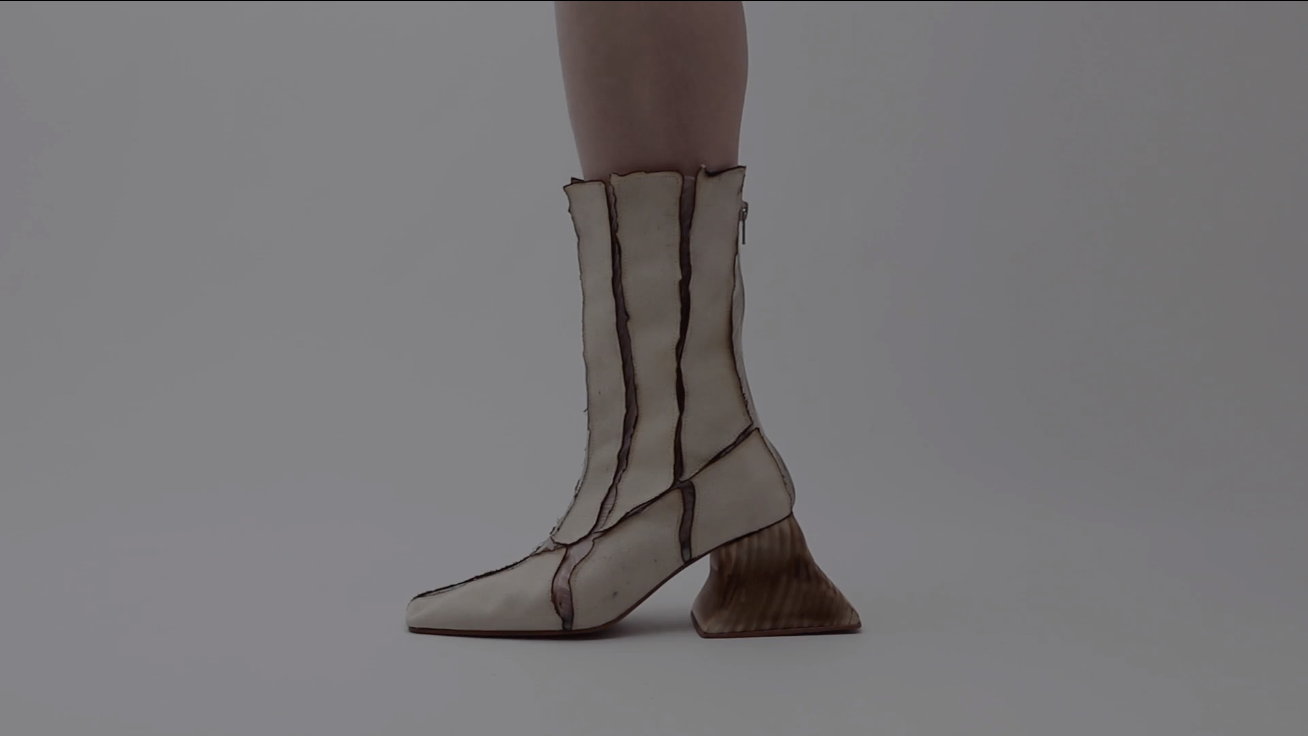
______________
Christian Marclay Record Without a Cover, 1985
‘Record Without a Cover was sold without any packaging, such that the wear and tear on it gradually transformed the sound of each copy. The record’s reverse side is printed with instructions not to “store in a protective package”, which gradually becomes less legible as the record is played repeatedly. The record’s transformation can be interpreted as a form of spontaneous composition, with each copy becoming a distinct performance. Marclay wanted to ensure that “you can’t ignore the medium”, and the evolving sound of the record blurs what he originally recorded with the way in which the record has physically changed.’
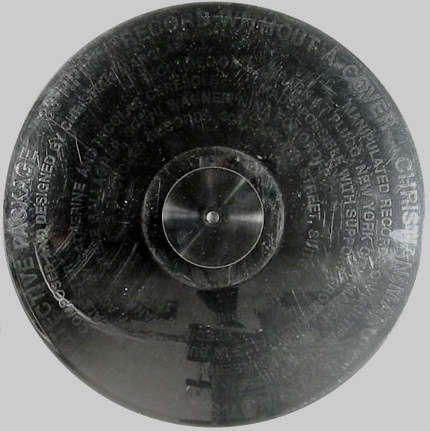
______________
Liz Larner Corner Basher, 1988
Steel, stainless steel, electric motor with speed-control mechanism 306 × 94 cm
______________
Janine Antoni Lick and Lather, 1993
‘7 chocolate and 7 soap self-portrait busts. The artist created the sculptures from molds of her own head. Then she licked the chocolate bust until it’s feature becomes blurred, and she took the soap bust into the shower with her, letting the water worn away the feature of the sculpture. Hence the artworks name is Lick and Lather.’

______________
Kurt Kren Self-Mutilation, 1965
‘The theme of Self-Mutilation (also referred to as Self-Destruction) is self-explanatory. Kren’s 10th film of 1965 depicts a man covered in white plaster and dough inflicting pain or attempting to operate on himself. The whole thing is very graphic and deeply unpleasant to watch. That, of course, is the intention; to shock the viewer and challenge perceptions.’
______________
Douglas Gordon Self-Portraits of You + Me, 2006
‘With ‘Self Portraits of You and Me´ by Douglas Gordon, the viewer is denied engagement with the subject (celebrities) because all discriminating facial features have been removed by burning. Frames backed with mirrors were constructed so that the viewer’s gaze is quite literally reflected back out of the photographs through the holes in the images.’
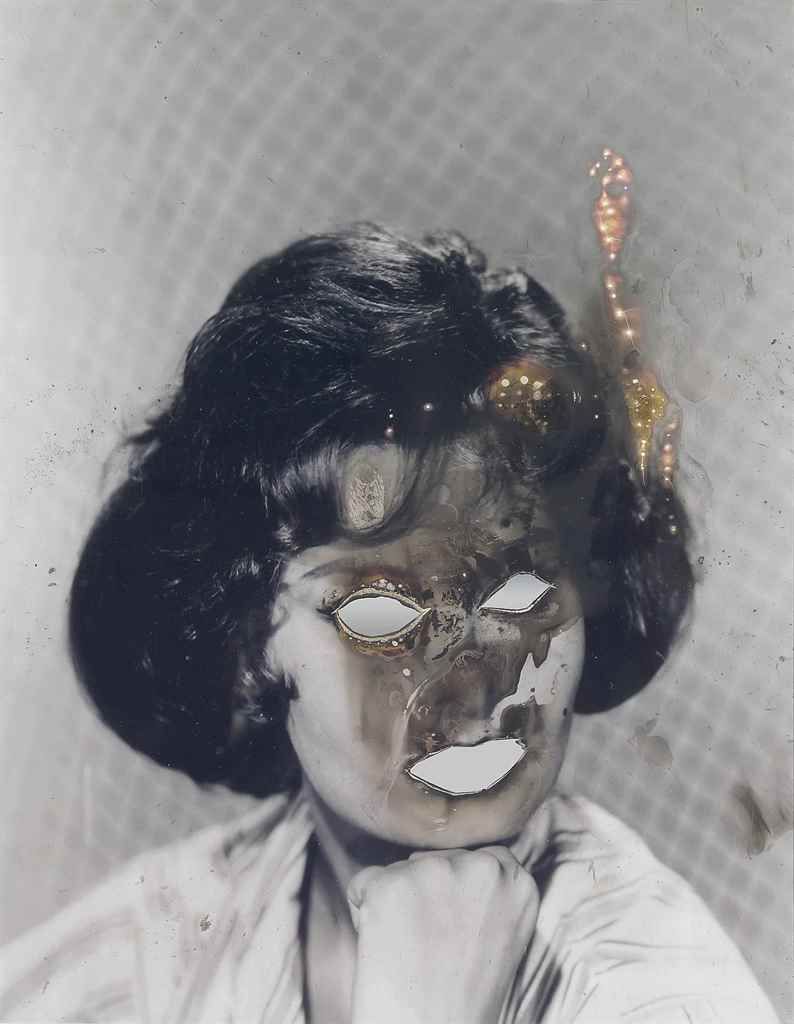

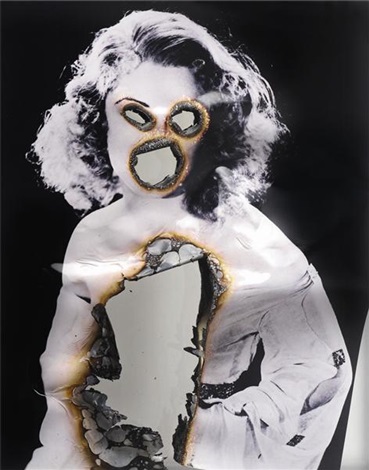


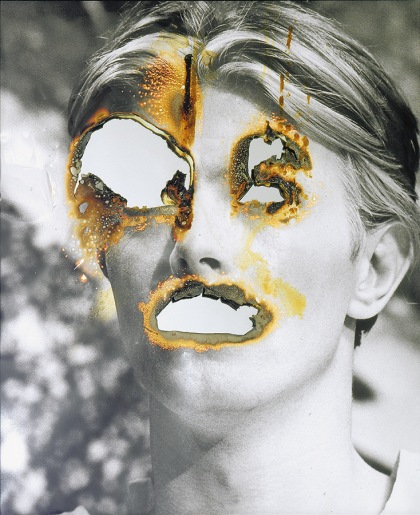
_______________
Jonathan Schipper Slow Motion Car Crash, 2012
‘In his 2012 performative work staged over the course of a month, Jonathan Schipper’s Slow Motion Car Crash sees a white Volkswagen destroy itself by slowly crashing into a wall—propelled forward by a pneumatic mechanism beneath the vehicle that moves at a rate of seven millimeters per hour. The car’s movement is almost undetectable to the human eye, and barely evidenced in a time-lapse video of the event. But the car’s form gradually degrades.’
_______________
Teresa Margolles Tongue, 2000
‘perforated human tongue with a piercing of a teenager murdered in a street fight, 70 x 20 x 90 mm’
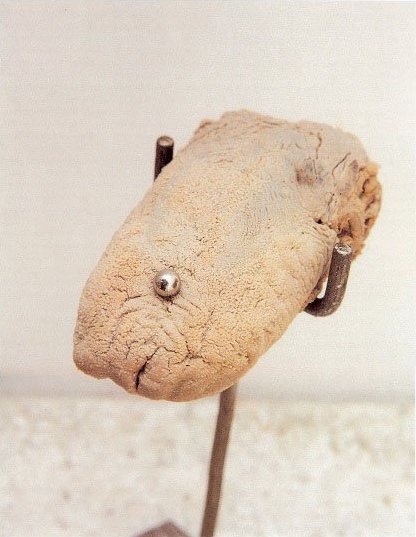
_______________
John Baldessari Cremation Project, 1970
‘In 1970, conceptual artist Baldessari rounded up all of his unsold paintings from May 1953 to March 1966, took them to a crematorium, and reduced them to ashes. In what he would later title Cremation Project (complete with documentary film and photos of he and his assistants burning his works), Baldessari effectively destroyed the abstract stage of his career. Having turned to more conceptual works involving text and photography, Baldessari ritualistically closed the door on one style to make way for the next. The artist had a bronze commemorative plaque made for the works’ “burial.”’
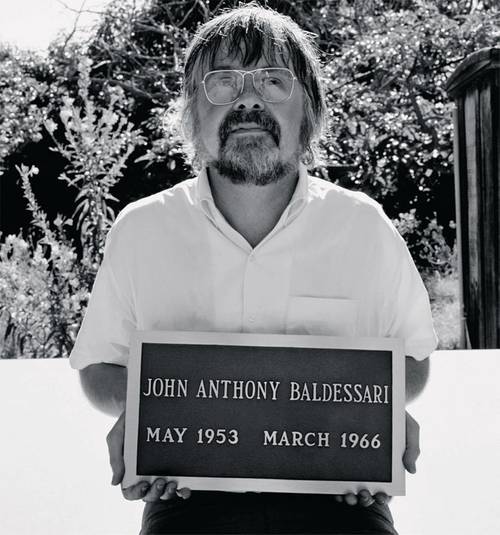

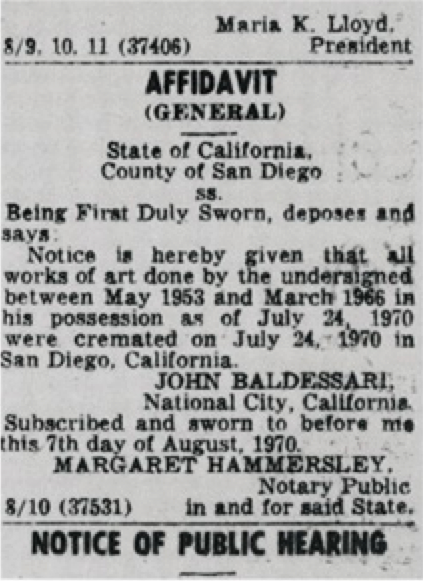
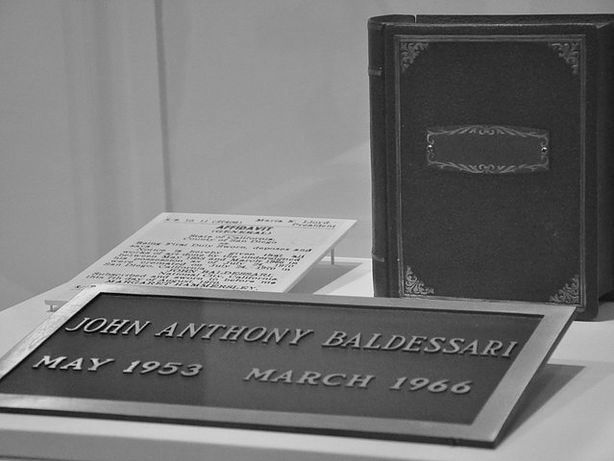
_______________
Gustav Metzger Various, 1965 – 1992
‘Auto-Destructive Art (ADA) is a form of art coined by Gustav Metzger, an artist born in Bavaria who moved to Britain in 1939. Taking place after World War II, Metzger wanted to showcase the destruction created from the war through his artwork. This movement took place in England and was launched by Metzger in 1959. This term was invented in the early 1960s and put into circulation by his article “Machine, Auto-Creative and Auto-Destructive Art” in the summer 1962 issue of the journal Ark.’
________________
Urs Fischer Francesco, 2017
‘Swiss artist Urs Fischer captures the passage of time in his remarkably life-like candle portraits. Made from 3D body scans, Fischer’s sculptures closely resemble their muses: He has crafted candles of artist Julian Schnabel, restaurateur Mr. Chow, and art collectors Bruno and Yoyo Bischofberger, among other figures, carving out their features and rendering their clothing in colored wax. Fischer’s candles burn progressively over the course of a few months, prompting the viewer to confront life’s slow decay and the march towards mortality. As the sculptures burn from the head down, they become disfigured, parts of their physical form dripping down in long, thin strips of wax—until all that is left is a puddle on the floor.’

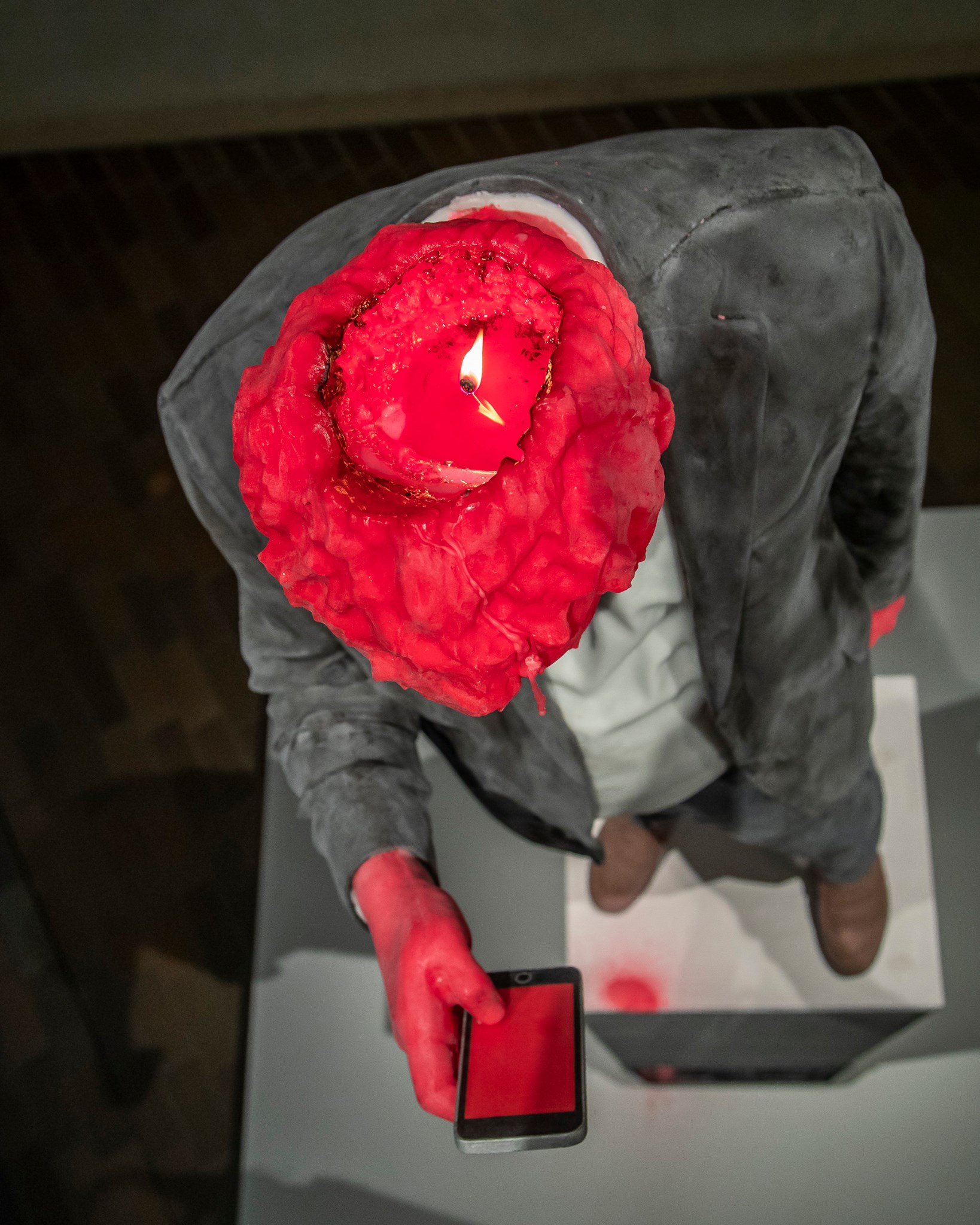

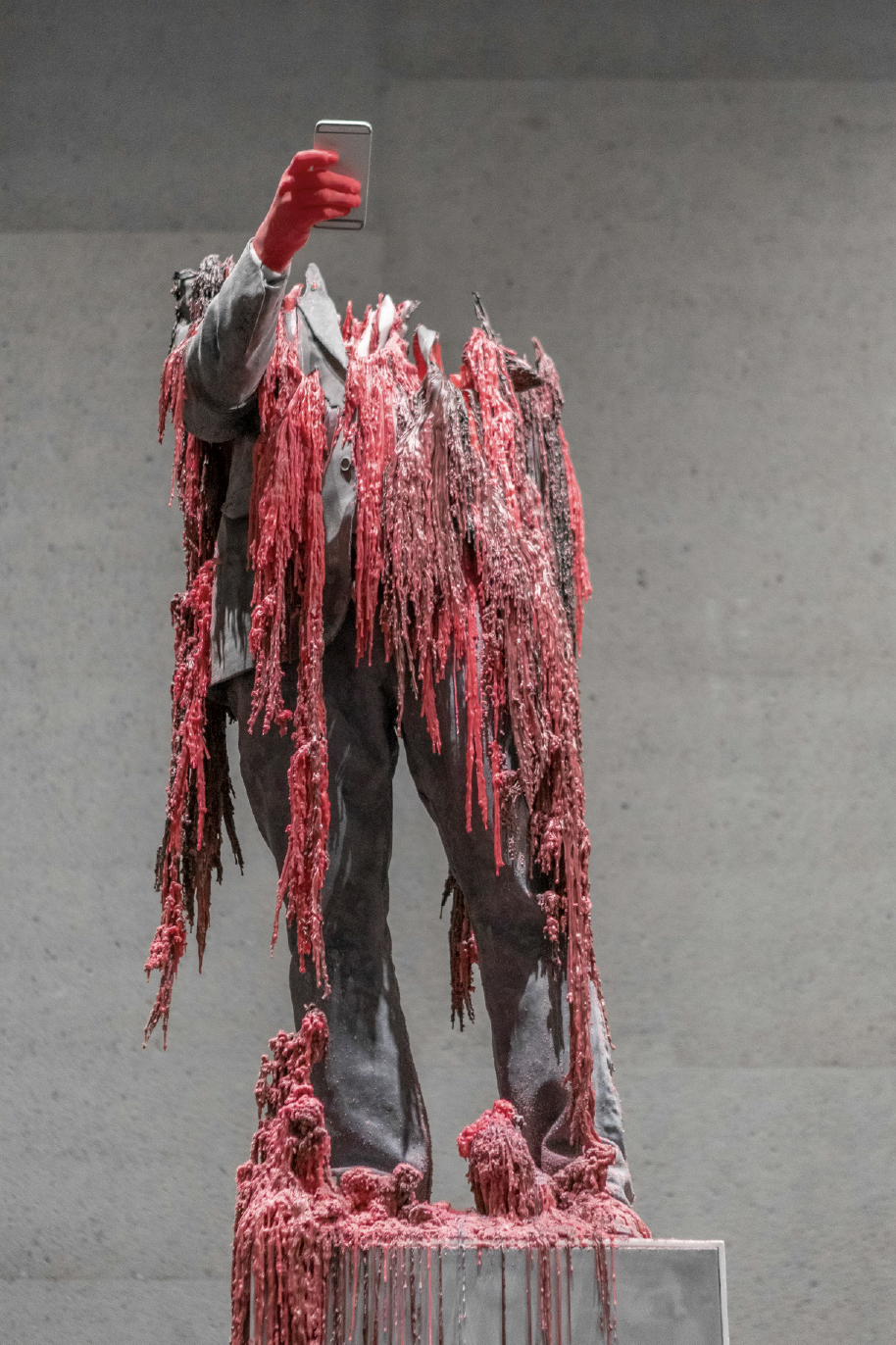
________________
Nam June Paik One for Violin (Solo), 1962
‘Nam June Paik’s 1962 work One for Violin (Solo) predated what the Who did by two years.’
________________
Tom Laduke Various, 2009 – 2010
‘In Auto Destruct, LaDuke’s dark, narrative paintings present layered scenes in which imagery surfaces and materializes briefly as we direct attention to it, only to become subliminal again when we focus elsewhere.1 In each canvas are at least three layers, one superimposed upon the other. LaDuke brings together appropriated film stills with images of his studio and art historical masterpieces. Both the filmic “ground” and the intermediate layers, derived from photographs taken of his studio, are laid down in muted hues of transparent, airbrushed acrylic. Optically, the filmic and studio layers intermingle yet vie for preferential treatment, although typically the filmic wins out. Perhaps this is because the ratios of the paintings approximate those of film and television screens and so we see them more readily. Or more likely, we have viewed these images before, either in the films themselves or reproduced as stills. Because they are already lodged in our memory, the filmic imagery passes a kind of “truthfulness” test. Meanwhile, the art historical source material sits heavily on top of the paintings’ surfaces, rendered piecemeal in thickly applied oil paint. Almost utterly reduced to scattered, expressionistic blobs that for the most part refuse to coalesce into a recognizable image, the masterpieces passively nag at us to “re-member” them.’

Auto Destruct 1

Auto Destruct 2
________________
Yoko Ono Smoke Painting, 1961
‘To make the painting, Ono would take a blank canvas made of cloth and place a fire near the canvas, until the canvas slowly burned away. In her first showing of the painting, she used a candle to burn away the canvas, but her original conceptualization of the work suggests using a lit cigarette.’
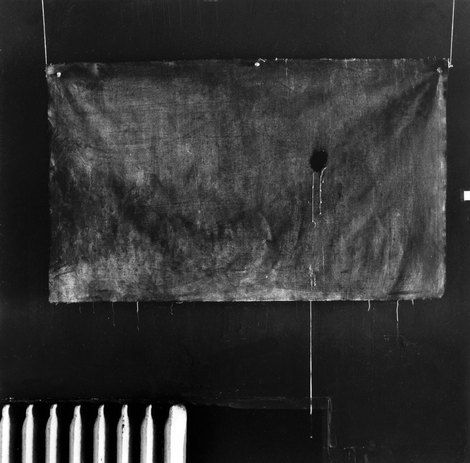
________________
Raphael Montahez Ortiz De-Struction Ritual: Henny Penny-Piano-. Sacrifice- Concert, 1967 (2014)
‘In 1960 the New York destructivist Raphael Montañez Ortiz first took a sledge hammer to a piano; the preferred object of his ritualistic wrath (as of 2007, the still-living artist has destroyed around 80 more). For Ortiz, who penned a manifesto in 1961, destruction is a much more metaphysical matter, motivated by a protest against death and steeped in a kind of Bataillian rhetoric of sacrifice and transcendence.’

________________
Keri Smith Wreck This Journal, 2007
‘This is a book that is designed to be ruined by the owner. I know it doesn’t technically destroy itself, the book is basically a set of instructions which asks the reader to inflict damage, so it’s participatory.’
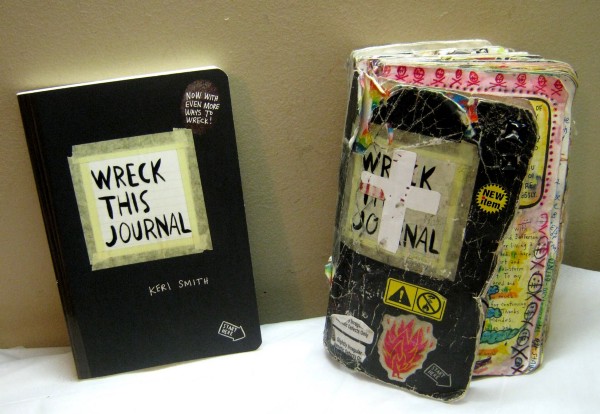
________________
Kobayashi Eitaku Body of a Courtesan in Nine Stages, 1870s
‘“Body of a Courtesan in Nine Stages” is an example of kusozu, the illustration of a decomposing corpse, that was popular in Japanese art from about the 13th to 19th centuries. Kusozu was inspired by Buddhist beliefs that urged followers to meditate on the temporary nature of life and the physical world by contemplating postmortem changes. The below panels illustrate nine stages of death that include: (1) dying; (2) newly deceased or fresh; (3) skin discoloration and bloat during early decomposition; (4) leakage of blood in early decomposition; (5) skin slippage, marbling, and leakage of purge fluid during early decomposition; (6) caving of abdominal cavity and exposure of internal organs during advanced decomposition; (7) animal scavenging during advanced decomposition; (8) skeletonization; and (9) extreme decomposition. Though the painting maybe religious and/or scientific in nature, according to the British Museum it also has erotic themes. Because the subject matter is a courtesan, the curator notes for this piece at the British Museum say that this handscroll also falls into the genre of erotic art, or shunga. The word shunga means picture of spring in Japanese. The word “spring” is a common synonym for sex.’

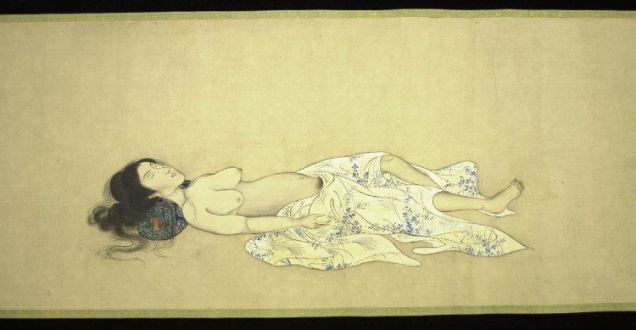

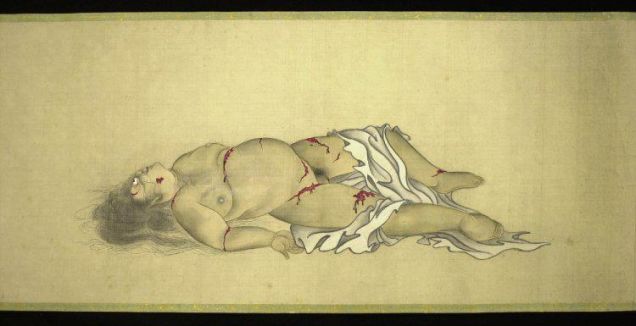

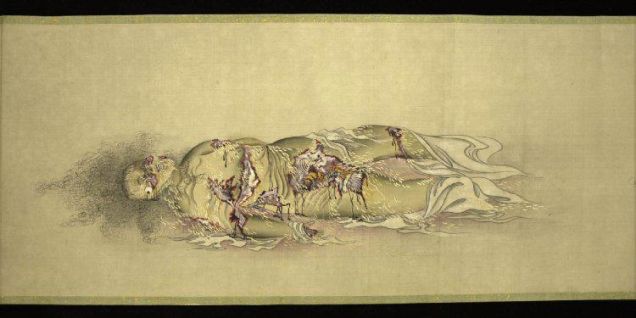

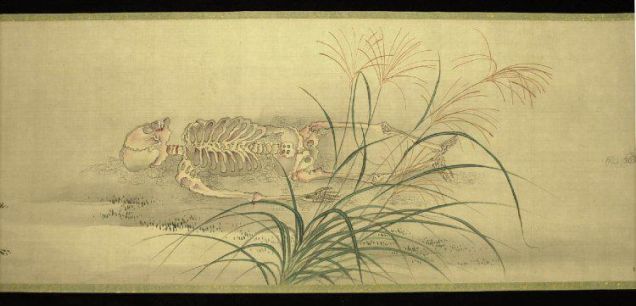

________________
Man Ray Object to be Destroyed, 1923
‘The earliest intentionally self-destructive artwork may be Man Ray’s Object to Be Destroyed, which was made in 1923. The original version of the artwork lasted until 1957, when the poet Jean-Pierre Rosnay led a student mob called the Jarivistes into an art gallery, stole Object to Be Destroyed, and shot it with a pistol. Man Ray objected to the destruction, saying that the Jarivistes were futilely protesting against art history, but Ray could not stop the title of his work from turning into a self-fulfilling prophecy. Ray would later make multiple copies of the original work, but retitle it Indestructible Object.’
_______________
Zoe Leonard Strange Fruit (For David), 1997
‘Leonard was a vocal AIDS activist in New York during the 1980s and 1990s, an era that witnessed the loss of many in the art world. In Strange Fruit (For David) (1997), Leonard poignantly responds to this tragic history through an installation composed of dried fruit skins discarded seemingly at random on the gallery floor. The title of the work references the iconic anti-lynching song, written by Abel Meeropol in 1937 and whose most famous recording features Billie Holiday, and the installation’s dedication to the artist David Wojnarowicz who died of AIDS in 1992 reveals this strange fruit to be haunting symbols of those victimized by the virus and society at large. The decaying fruit also alludes to the art-historical tradition of the vanitas still-life, a genre of painting in which ephemeral objects such as flowers, flickering candles, and skulls were depicted to symbolize human mortality. Yet, closer inspection reveals that Leonard has sutured the fruit back together with needle and thread, suggesting art’s potential to heal.’
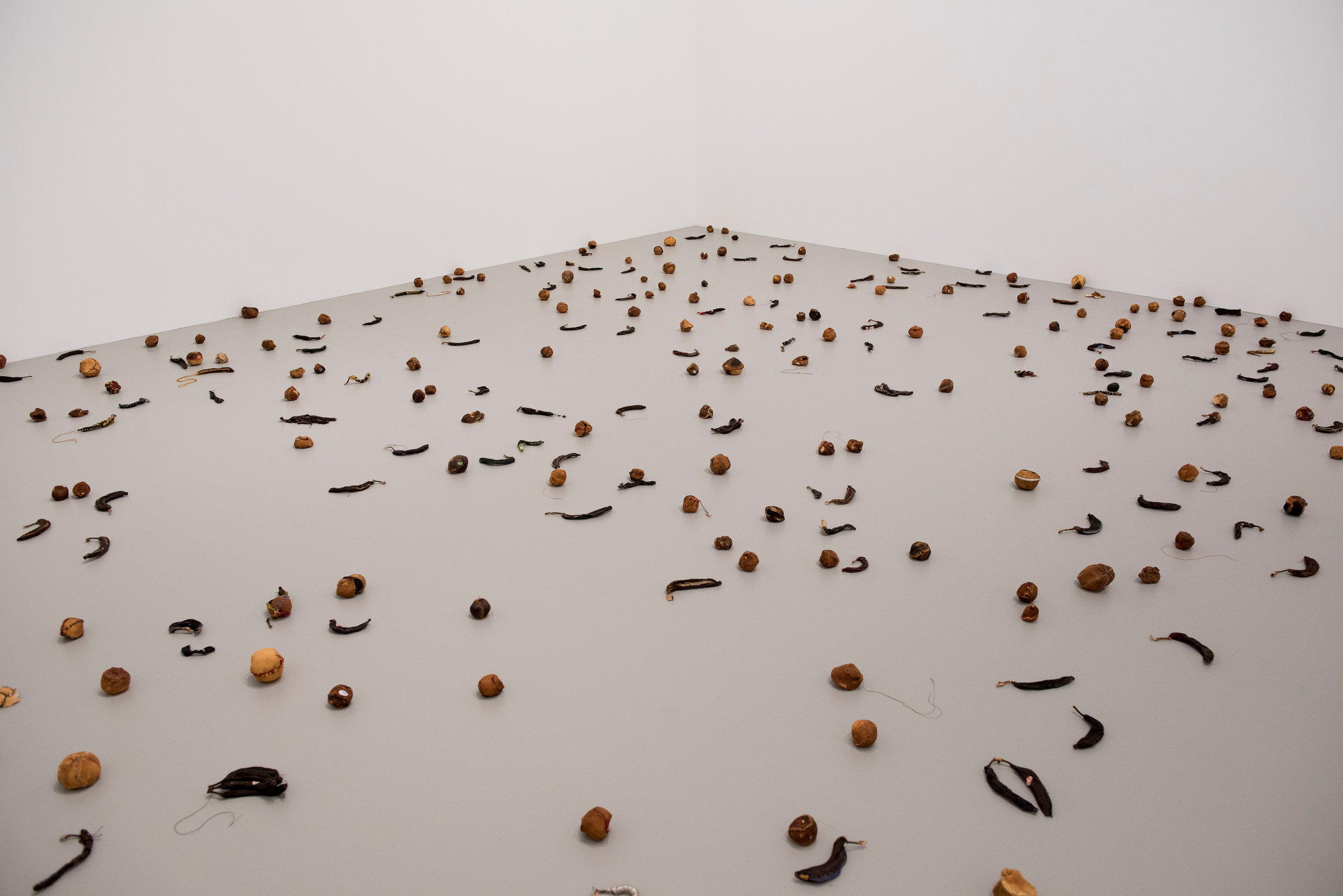
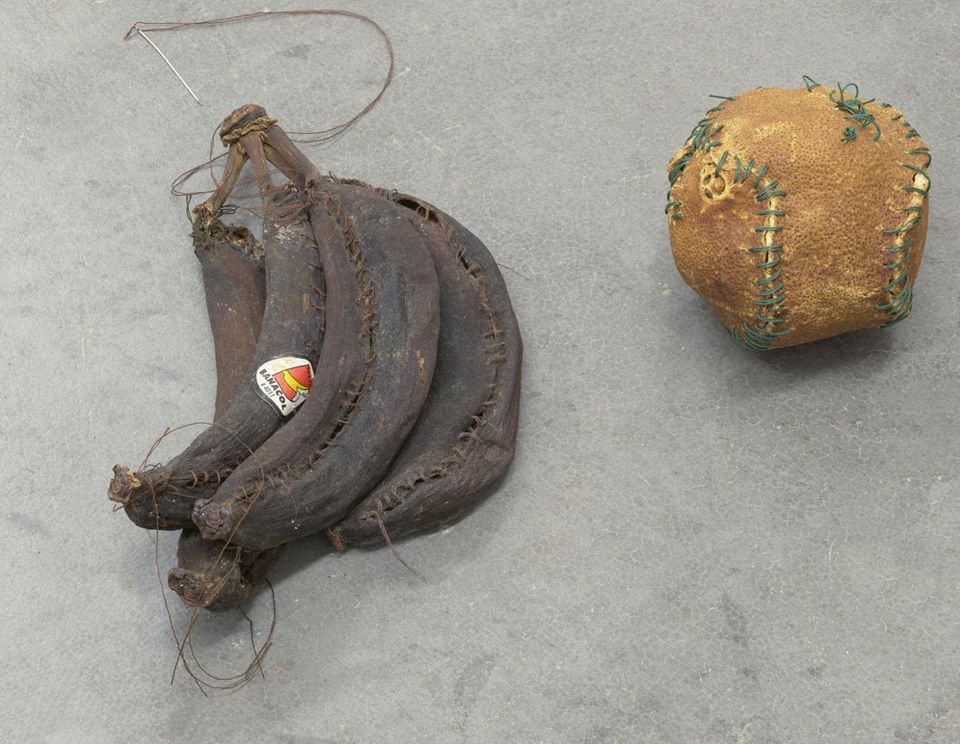
_______________
Arcangelo Sassolino Various, 2006 – 2012
‘Arcangelo Sassolino was born in Vicenza, Italy in 1967 where he still lives and works. His works and installations explore mechanical behavior in machines and materials as well as the physical properties and results of forces. Sassolino’s studio location, in the industrial north of Italy where the landscape has given way to industrial factories and an urban landscape, provides an endless resource in mechanical and industrial production. By applying to materials physical natural phenomena such as gravity, speed or pressure, a new potential is unlocked and allows a manipulation in the solidity of certain constituents. The functionality of the machinery used to exert these forces becomes an aesthetic of its own.’
________________
David Hammons Cold Shoulder (1990)
‘Cold Shoulder (1990) comes to mind as one of David Hammons’ more flippant – the work consisting of pimp-style fur coats, shoulder-slung across blocks of ice. Yet the title’s flagrancy, its sheer obviousness, constitutes a large part of the work’s effect, serving as a reminder of how inescapable, how painfully blatant, issues of race and class are in America. So much so, indeed, that the risk is they become almost invisible.’
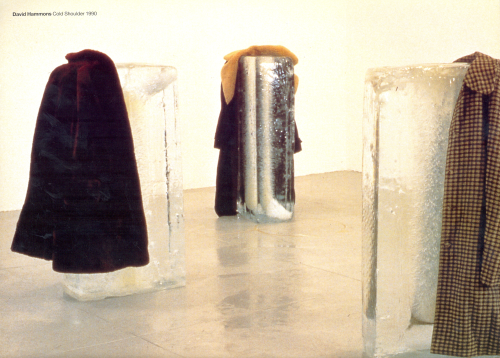
________________
Pope L. Claim, 2017
‘Art critics noted the stink as soon as the elevator opened. Indeed, the morning of the Whitney Museum of American Art’s Biennial preview, Pope L.’s contribution smelled like rotten lunch. For good reason: Claim consists of 2,755 bologna slices nailed in grid formation on the walls of a small, freestanding room within the exhibition. Plastic basins catch the grease run-off along the museum floor. By early April, nearly a month later, the stench had faded considerably and in May, it seemed gone, as the bologna dried—or “cured” per ArtNews—into something probably more akin to beef jerky now. Claim considers the usefulness of race as a social category: Affixed to each piece of meat is a photocopy of someone who may or may not be Jewish. According to the Whitney’s label, the number of slices reflects 1 percent of the Jewish population in New York. Or not. The math, we’re told, is a “bit off”— a deliberate misrepresentation that doesn’t actually correspond to census data, the pictures taken at random. But among the questions it presents, Claim, more than other artwork in the Biennial, stresses the unique problems museums and collectors face as contemporary art grows more ambitious in its materials: how to conserve works made of substances meant to last for several days or weeks. After all, it’s difficult to imagine bologna portraits transcending millennia like a classical marble bust or centuries like a Rembrandt. Getting a sculpture made of deli meat to survive the decade could even be a stretch.’
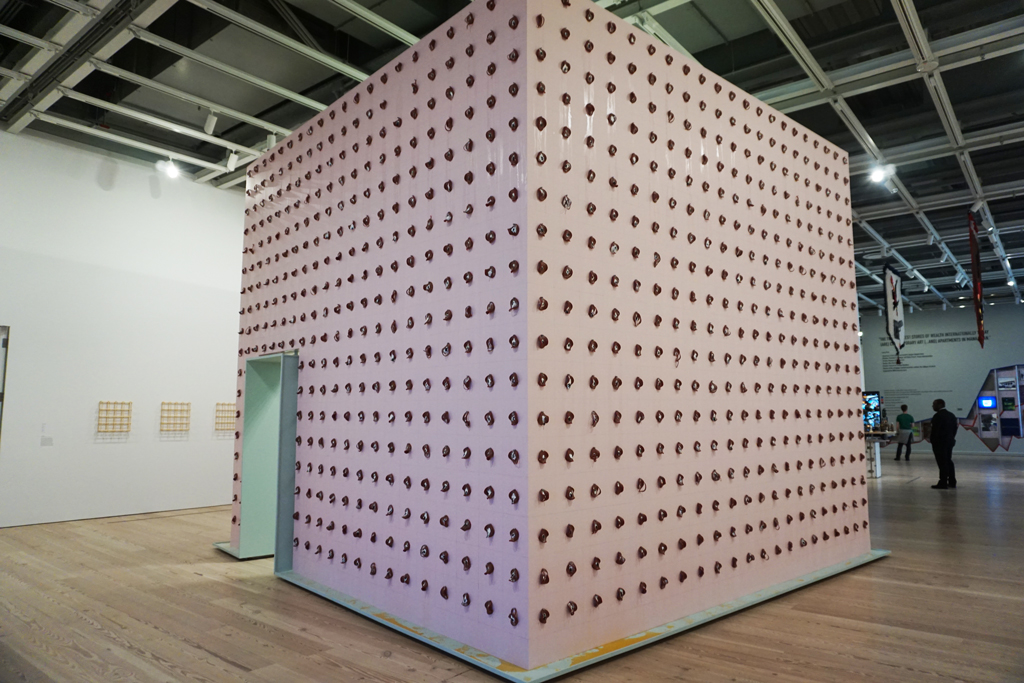

________________
Daniel Arsham Various, 2013 – 2018
‘Arsham’s art focuses heavily on the combination of natural forces meeting architecture in examples of decay, destruction, and general cognitive dissonance. For his modern sculptures, he uses basic materials like broken glass or hydrostone to produce life-size human figures and technological objects like boom boxes, cameras, and video game controllers.’
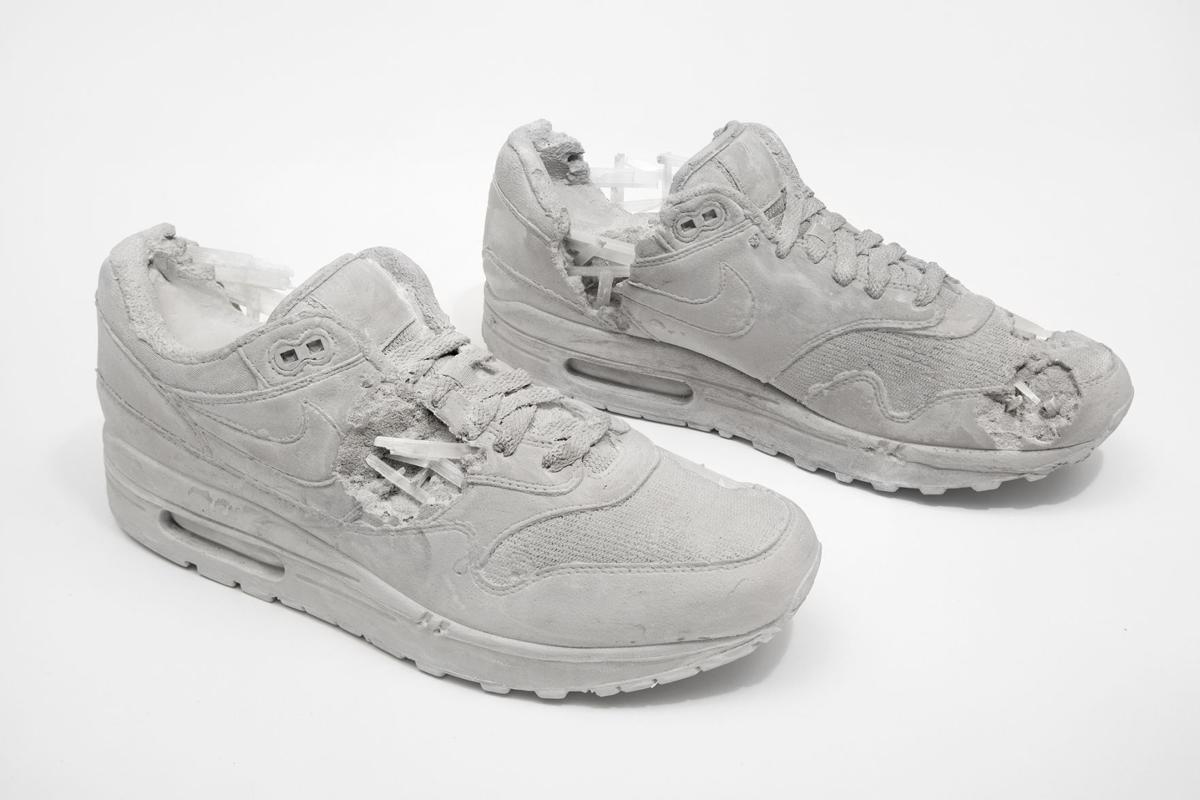


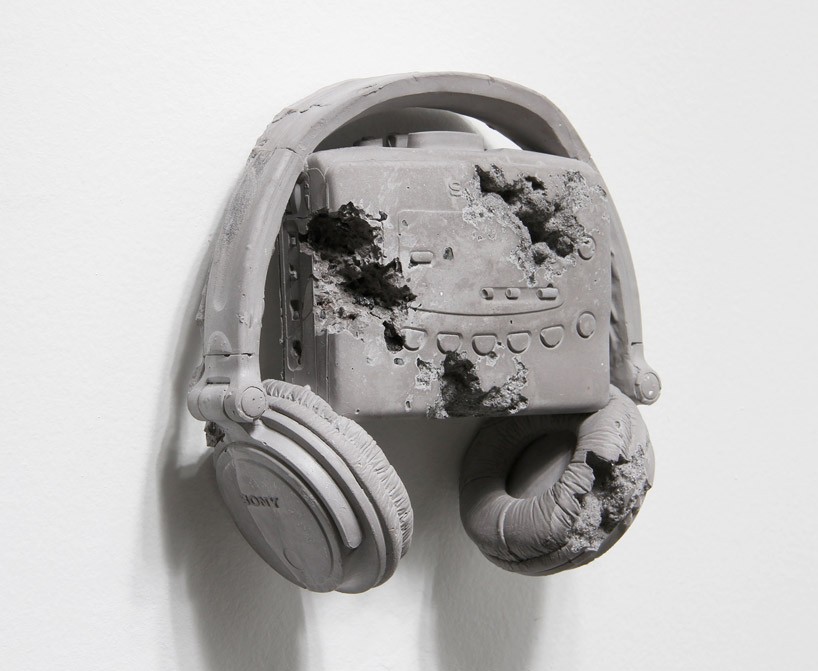
________________
Charwei Tsai Love Until I Rot, 2007
‘Love Until I Rot was a project where I was approached with the curatorial question: “How far would you go for love?” I responded by making a foot out of cheese, using a mould of my own foot, then tattooed on the ankle the text, “Love until I rot”. The work was to question the concept of everlasting love. In this work, I captured the transformation of the material by filming the cheese foot rotting from heat, as well as the changes to the text.’
________________
Saburo Murakami Iriguchi, 1955
‘In Saburo Murakami’s Iriguchi (Entrance, 1955), the artist stretched paper through an interior doorway, then hurled his body through it, creating a record of transgression through a traditional Japanese wall, never to be made whole again.’
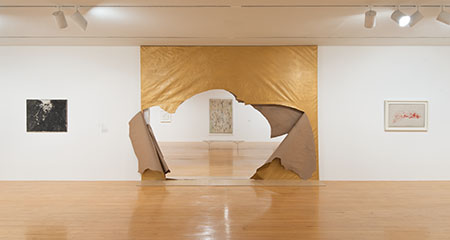
________________
Jean Tinguely Homage to New York, 1960
‘In 1960, Swiss artist Jean Tinguely was commissioned to create a performative work in the sculpture garden at New York’s MoMA. He produced a 27-foot-tall towering tangle of discarded iron fragments; remnants of a piano, go-kart, and bathtub; motors; wheels. Titled Homage to New York, the work was intended to transfer kinetic energy from one part to the next before destroying itself entirely. But an errant spark foiled Tinguely’s plans: The sculpture caught fire and was ended preemptively by the New York Fire Department a mere 27 minutes into the performance.’

*
p.s. Hey. ** David Ehrenstein, Hi. I didn’t know he wrote lyrics. Their charm is not something that’s hard to imagine. ** _Black_Acrylic, Hi, Ben. I’ve seen ‘Fresh Acconci’ and it is unsurprisingly very rollicking. So scary when the internet goes out and, yes, more scary to realise how stranded that leaves you. Happy that you remain a Play Therapy upping demon. Look forward to it. ** Damien Ark, Hi, Damien. Thanks, I think I’m safe. Quarantines will do that. Or I suppose my building could burn down or something. So far so good. Pre-order, whoa! So close! My email is: denniscooper72@outlook.com. Well, I guess do your best to concentrate on the triumph of the publication of your first novel. That’s no small thing whatsoever, and I can tell you, or at least suggest to you, that that’s one of the real and truest life highlights one gets, and an occasion for which you should allow yourself to feel a lot of happiness and pride. It’s a very bright bright side. man. And hang in there in and around that in any case. Love, etc., me. ** Brian O’Connell, Hey Brian. Yes, all thanks to Grant, and I hope he peeks into the blog and sees his gift is alive again. Oh, shit, I’m so sorry, Brian. That’s really rough about your dad, and consequently for you and your mom. Why a truly horrible, fragile time this is. Twitter is the one platform that I’ve never considered joining for one second precisely because almost everyone I know there has stories just like yours. It seems like you have like or fetishise being stressed to want to be there. I suppose one could say that about Facebook, where I am too, but I’ve developed the knack of hauling ass past the trolls. Anyway, warm hugs about your yesterday, and … onwards and upwards from there, I hope? My yesterday did have a treasure chest quite unexpectedly. There’s been this looming possible breakthrough re: the making of Zac Farley’s and my next film, and yesterday, thanks to a Zoom conference call, it happened. I can’t really talk about it yet, but as of now we will definitely be able to raise the funding and shoot the film possibly as early as next summer, and I’m over the moon relieved and happy about that. So a rare heavily reward-filled yesterday for me. Now let’s put our mental magic together and get you one ASAP. ** Bzzt, Hi, Q! Yes, and it looks completely beautiful. I’m hoping to get to read it later today once I get a couple of obligations out of my hair. Yay! Everyone, Here’s a total treat. Two very fine artists who also happen to be distinguished locals of this very blog have a new thing up at the excellent Evergreen Review. It involves a short fiction work by Quinn ‘Bzzt’ Roberts and imagery by Brendan ‘Brendan’ Lott. A must read and viewing if there ever was one. And, if that’s not alluring enough, it’s called ‘The Whore Stuff’. Find it here and enjoy! Yeah, it’s weird, and it’s also the best feeling ever, no? And a great building block for your work and confidence. Let the happiness reign. ** Steve Erickson, Hi. Yeah, if I were choosing a social media platform now, I’d join Instagram over Facebook for sure, but between this blog and Facebook, I just don’t have any more time/room for another consuming site I would inevitably spend every day checking constantly. Glad to hear you’re getting into the Coates album. Lock downs/quarantines suck for all kinds of reasons, but we’re a few+ weeks into ours, and the infection rate in France is dropping precipitously, and we might even get to start reopening again somewhat soon, all of which is to say it seems like that drastic measure works, and that’s the point. Good luck whatever comes down over there. ** Right. Watch some things destroy themselves today if you’re so inclined. See you tomorrow.




 Now available in North America
Now available in North America 
Aaaaw so much destruction! Nice!
So glad you included “Homage to New York.” It’s the first thing I think of when it comes to self-detruction.
Here’s a favroite Kern/Wodehouse, with June Allyson and the lovely Ray MacDonald
Thanks so much Dennis!! Glad to hear you like the title. I think D might be pitching something for Evergreen’s spring issue so that’ll be lots of fun too. Hope you make progress on your tasks, I myself should really buckle down…!
Dennis,
My name is Kaley, and I am taking a course where we are trying to analyze your book, Frisk. My instructor enjoys your literature and had us read it for our novel unit. The class is somewhat split on a topic. In your book, we talk about how the name Dennis is literally your name. Some believe that it is an auto-fiction, but some think that the character is connected to you somehow. Personally, I believe that even though this could be a novel, it somehow relates to your life (please let me and the class know if it is). I started to think about how it was so crazy that it might be true. In the section, Torn, you talk about Joe being stabbed by Gary, then you mention how Samuel and Dennis know each other. I know in your first novel of the series, you talk about George Miles and I assume you are related to the Dennis in the book, since you two know each other. I was wondering how you came up with the plot of that section. Our class thought of a couple of reasons why: you are Dennis (and therefore an accomplice of the murder), this is a news story you saw on the news or read about and used that as inspiration, or that you are just super creative and have a wonderful imagination. We are all genuinely curious, and I know this is not a usual reply you get but my instructor encouraged me to write to you so I could find out myself.
The class and I admire your work and find it so interesting. We were even wondering if you would come video chat with us about your book. We all have so many questions for you. Please feel free to email me if you ever get the chance.
Thank you!
Kaley Gott
University of Iowa
Would these Felix Gonzalez-Torres piles of candy count here? They were intended to be eaten by viewers, who would digest the sugary sweet content along with the work’s meaning. I always had a fondness for his art, which was some of the first conceptual work whose meaning I felt able to comprehend as a teen.
A Nico quote that comes to mind: “All true artists must self-destruct.” Well, she certainly followed her own advice…
I mentioned that Buddhist “9 stages of decomposing corpse” thing in HARLEM SMOKE, only in my case it was a monk instead of a courtesan.
In a book I own on Siouxsie & the Banshees they discuss the band’s first tour in America and how Siouxsie said she liked America because it gave her something to hate again. That’s kind of how I feel about Twitter, ha ha… I’m really just on there because of James Nulick and a few others, really.
https://youtu.be/nQy9bpkcnqU
Dennis! Quinn and I joining forces to conquer the world is such a wonderful and unexpected highlight of this shit year. Thanks for the shout out on the blog. I emailed you shots on the show.
I love the Miami Vice story! There’s only one other guy I know of with my name and he appears to be a musician in Australia or something. Not quite the same thing as a writer for a hit TV show. But maybe it will work in my advantage sometime. Artist, photographer, musician, Australian is quite the resume.
Love, B
Hi, Dennis,
Everything on here today is amazing, but the Kobayashi Eitaku is something else. (And the Burden; the terrifying Kurt Kren; the Teresa Margolles—is that actually a real tongue?!—the Urs Fischer sculptures, one of which I think I saw at the Whitney a long time ago; the Tsai…as I said, everything.) An oddly soothing collection for this shitty time.
Yeah, it’s bad about my father’s job. I’m sure we’ll be fine. But it obviously sucks and is a little scary and in any case pretty depressing. Oh well. Onwards and upwards indeed. You have the right idea about Twitter. It’s an absolutely toxic place, and I only stay on it because I’ve become unfortunately kind of addicted to it. But I’m trying to get better with limiting my interactions there to actual friends, and also avoiding engaging with content that will clearly draw trolls (the paradigmatic failure of which occurred during the “Cuties” debacle; that should’ve taught me my lesson). I’ve always had a better experience on Facebook, even though that’s riddled with problems too, of course. Social media is really a poisonous thing in general, probably.
Oh wow, a treasure chest indeed! That’s so exciting about the film. Much-needed good news. Congratulations, and I can’t wait to see it. Ah, I understand that you can’t spill any details, but do keep us posted as much as you’re able, of course. Cheers!
Great to hear of the breakthrough on the upcoming film project! Congratulations!
Today’s theme is unsurprisingly near and dear to me. Besides a few old favorites, that tongue piece is quite deliciously creepy. And those Japanese decomposition prints, whew.
Bill